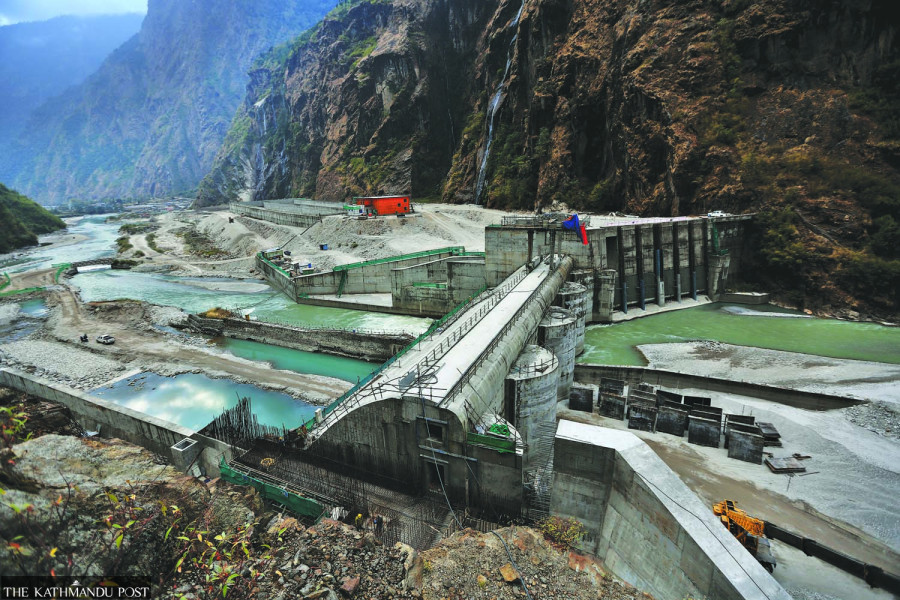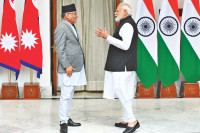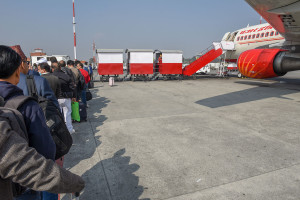Special Supplement
Yearender 2022: Hydro sector thrives amid geopolitical landscape
Despite a growing positive environment for expanded market access for Nepal’s power, the country faces a number of challenges
Prithvi Man Shrestha
Nepalis suffered for decades from load-shedding, or power cuts that plunged whole sections of the city in darkness that sometimes lasted 18 hours. In 2017, the rolling blackouts ended for the general public thanks to an extraordinary official who had the courage to challenge the status quo, and people didn't have to light candles anymore or rely on expensive power supply equipment that only the rich could afford.
After four years in 2021, Nepal stunningly earned the status of a power surplus country during the wet season being able to export on a small scale. A year later in 2022, Nepal even started selling electricity on a commercial scale.
From lighting candles to exporting electricity, Nepal made a turnaround in a few short years that is nothing short of astonishing. Now they are even saying that electricity will become Nepal's largest export in a few years. Analysts say that is true, but geopolitics is emerging in the energy sector too.
Nepal earned significant amounts of revenue by exporting electricity to India in early June 2022 when exports of other commodities had slumped sharply. State-owned power utility the Nepal Electricity Authority (NEA) said that it earned Rs11.16 billion by selling electricity in the last six months before stopping exports in the third week of December. During the current fiscal year that started in mid-July, the utility exported power worth Rs8.32 billion.
“Had India granted approval to export power from more power projects during the period, Nepal’s export earnings from India would have been higher,” said Ashish Garg, vice-president of the Independent Power Producers Association of Nepal (IPPAN).
The NEA witnessed spillage of power during the wet season (May-November) this year as domestic demand decreased while India delayed granting approval to more projects to export power to India. In the last fiscal year, the country exported power valued at Rs3.8 billion including the power exported in November last year and June and July this year.
The surge in the country’s electricity exports coincided with a sharp plunge in exports of other commodities. During the first five months of the current fiscal year, exports of other commodities fell by 34.61 percent to Rs67.30 billion. The NEA expects to increase electricity exports to India to Rs16 billion in the current fiscal year by exporting extra power in June and July when the wet season begins.
“As we are struggling to boost exports of other goods to India, electricity exports have shown great hope for Nepal to reduce the trade deficit with the southern neighbour,” former commerce secretary Chandra Ghimire told the Post in a recent interview. “The more important thing about electricity is that it is a product with one of the highest value additions in Nepal, and has had multiplier effects on the economy ranging from generation and transmission to distribution of power.”
Due to limited export earnings, the country has been heavily reliant on remittances sent home by migrant workers to maintain its foreign exchange reserves. In fact, even the limited exports are heavily reliant on two products, soybean oil and palm oil, in which there is insignificant value addition.
In the last fiscal year, soybean oil topped the chart with exports worth Rs48.12 billion followed by palm oil with Rs41.06 billion, according to the Trade and Export Promotion Centre (TEPC), a trade promotion agency under the Commerce Ministry.
“In the next few years, electricity will emerge as the number 1 export product of the country,” said Garg.
Petroleum products have been Nepal's largest import for the last several years. It has also been importing a large quantity of electricity from India despite being a water-rich country with lots of hydropower potential. The scenario now appears to be changing with the country reducing its electricity imports while boosting exports along with increased production of hydropower. Nepal endured load-shedding till May 2018.
Along with growing power production in the country, the power import bill has been on a decreasing trend. As Nepal’s power system is heavily reliant on run-of-the-river type hydropower projects, the country imports electricity from India in the dry season (December-April) when the water level in the rivers goes down.
In the fiscal year 2020-21, Nepal imported electricity worth Rs21.82 billion, according to the NEA. The power import bill decreased to Rs15.46 billion in the last fiscal year 2021-22. With the NEA targeting exports worth Rs16 billion in the current fiscal year, the country is likely to become a net exporter of power this fiscal year.
NEA Managing Director Kul Man Ghising said in a press statement, “But unlike in the past, imports this year will be lower than exports. We will be a net exporter of power in terms of both volume of energy and earnings.”
As Nepal produces more electricity than is consumed domestically, the country needs to find markets; and India, which is promoting green energy itself, has emerged as a big market for Nepal’s electricity.
India has been increasing the quantity of power that Nepal can sell in the Indian market, but delaying granting approval to more projects to sell power as Nepal desires. In the beginning, Nepal was allowed to sell just 39 megawatts of electricity produced by the 24 megawatt Trishuli Hydropower Project and the 15 megawatt Devighat Hydropower Project in November last year.
Now, the southern neighbour has granted approval for eight projects to sell over 450 megawatts of power to India, according to the NEA. Unlike in the past, the southern neighbour has also been flexible on developing a sub-regional electricity market encompassing Bangladesh, Bhutan, India and Nepal (BBIN).
In April, the then prime minister Sher Bahadur Deuba and Indian Prime Minister Narendra Modi agreed on the Joint Vision Statement on Power Sector Cooperation which talks about strengthening cooperation in joint development of power generation projects in Nepal, and development of cross-border transmission infrastructure and bi-directional power trade with appropriate access to electricity markets in both countries based on mutual benefit.
The two sides also agreed to expand cooperation in the power sector to include their partner countries under the BBIN framework, subject to mutually agreed upon terms and conditions between all involved parties.
In August, Nepal and Bangladesh decided to request India to allow the export of 40-50 megawatts of electricity from Nepal to Bangladesh in the initial phase utilising the high voltage direct current power systems located in Bheramara of Bangladesh.
Nepal has already notified India about the decision. “India is yet to respond on the matter, according to NEA officials. But India has lately been supporting the development of a sub-regional market.
“India has been increasingly supportive of the idea of giving access to its transmission infrastructure for sub-regional trade considering its own interest in creating a regional bloc under its control,” said Posh Raj Pandey, executive director of South Asia Watch on Trade, Economics and Environment, a think tank told the Post in an interview in April.
Despite a growing positive environment for expanded market access for Nepal’s power, the country faces a number of challenges to realise its potential. Lack of high-capacity cross-border transmission lines, as well as domestic infrastructure, could limit Nepal’s ability to export more power, according to officials and experts.
There are a dozen cross-border transmission lines between Nepal and India of 33 kV, 132 kV and 400 kV capacities, according to the Energy Ministry. Only the Dhalkebar-Muzaffarpur Cross-Border Transmission Line has a 400 kV capacity, which can transport around 1,000 megawatts of electricity.
The other 11 cross-border transmission lines can transport 5 to 125 megawatts of power only, according to a white paper on energy issued by the ministry in May 2018.
Nepal and India have agreed to build another 400 kV Butwal-Gorakhpur cross-border transmission line with joint investment. The two countries have agreed to set up a joint venture company in India to implement the project.
The Arun 3 Hydropower Project, which is being developed by an Indian company SJVN Limited, is also building its own dedicated cross-border transmission line between Nepal and India to export electricity generated by the project on the Arun River in eastern Nepal.
However, they are yet to be completed. Stakeholders say that lack of high-capacity transmission lines is one of the major hurdles in boosting exports to India and beyond.
“Even if a new cross-border transmission line is built, we don’t have a high capacity transmission line domestically to transmit power to the cross-border power line,” said Mohan Kumar Dangi, another vice-president of the IPPAN.
On the other hand, the government has also been delaying granting licence to the private sector to conduct power trade citing lack of legislation. An ordinance with the provision of granting licence to the private sector has been gathering dust at the President’s Office as President Bidya Bhandari has not authenticated it.
Experts say that allowing the private sector to do electricity business is crucial to explore new markets for Nepal’s power.
Another risk for Nepal is that it will be heavily reliant on the Indian market for power exports, and this could be used as a bargaining chip by India for its geopolitical interests. Nepal has to rely on India even to sell power to Bangladesh as the southern neighbour separates the two countries.
Nepal is concerned by the Procedure for Approval and Facilitating Import/Export (Cross Border of Electricity) by the Designated Authority introduced by the Central Electricity Authority, which has imposed restrictions on the trading of power generated by projects involving China.
“Nepal’s power sector is facing the risk of domestic politics and geopolitics,” said Garg.
Stakeholders say that exporting power has been necessary to prevent the spilling of energy in the short term. They, however, insist that greater efforts should be made to increase domestic consumption which will help boost the domestic economy.
“We have to connect the factories with high-voltage electricity,” said Dangi. “We have to move quickly to replace gasoline-powered vehicles and gas-burning kitchens with electric equipment.”




 9.12°C Kathmandu
9.12°C Kathmandu










